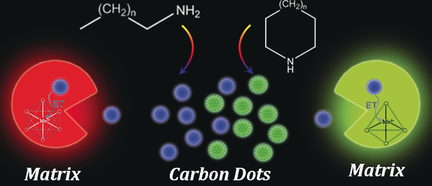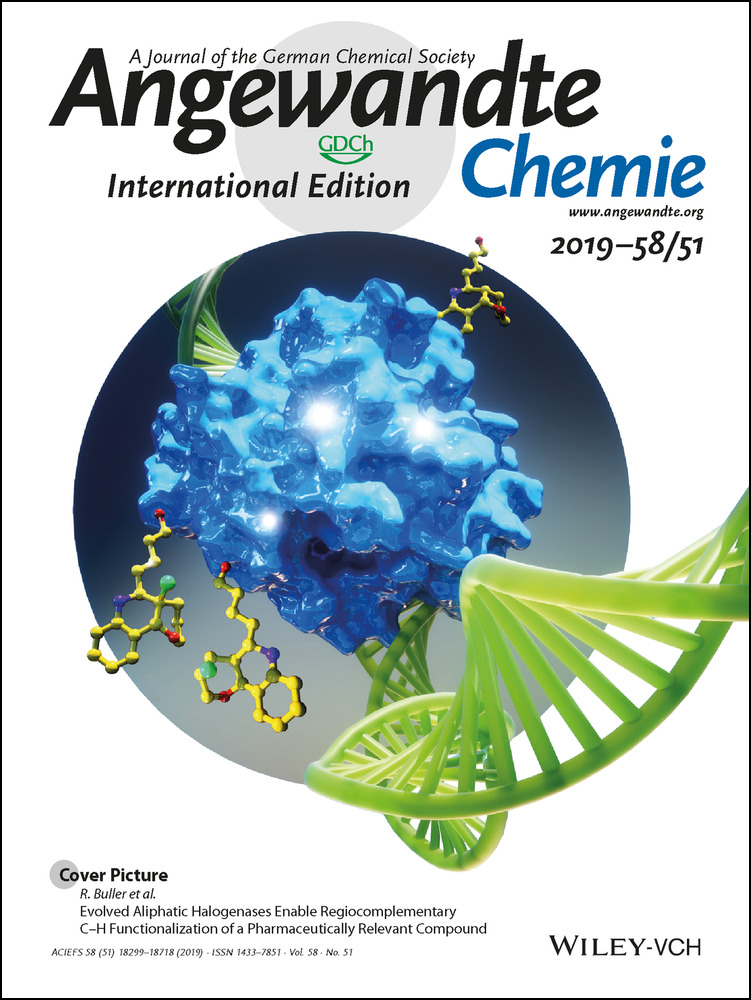Carbon Dots in a Matrix: Energy-Transfer-Enhanced Room-Temperature Red Phosphorescence
Bolun Wang
State Key Laboratory of Inorganic Synthesis and Preparative Chemistry, College of Chemistry, Jilin University, Changchun, 130012 P. R. China
Search for more papers by this authorYue Yu
State Key Laboratory of Inorganic Synthesis and Preparative Chemistry, College of Chemistry, Jilin University, Changchun, 130012 P. R. China
Search for more papers by this authorHongyue Zhang
State Key Laboratory of Inorganic Synthesis and Preparative Chemistry, College of Chemistry, Jilin University, Changchun, 130012 P. R. China
Search for more papers by this authorYuzhi Xuan
State Key Laboratory of Inorganic Synthesis and Preparative Chemistry, College of Chemistry, Jilin University, Changchun, 130012 P. R. China
Search for more papers by this authorGuangrui Chen
State Key Laboratory of Inorganic Synthesis and Preparative Chemistry, College of Chemistry, Jilin University, Changchun, 130012 P. R. China
Search for more papers by this authorWenyan Ma
State Key Laboratory of Inorganic Synthesis and Preparative Chemistry, College of Chemistry, Jilin University, Changchun, 130012 P. R. China
Search for more papers by this authorCorresponding Author
Prof. Jiyang Li
State Key Laboratory of Inorganic Synthesis and Preparative Chemistry, College of Chemistry, Jilin University, Changchun, 130012 P. R. China
Search for more papers by this authorCorresponding Author
Prof. Jihong Yu
State Key Laboratory of Inorganic Synthesis and Preparative Chemistry, College of Chemistry, Jilin University, Changchun, 130012 P. R. China
International Center of Future Science, Jilin University, 2699 Qianjin Street, Changchun, 130012 P. R. China
Search for more papers by this authorBolun Wang
State Key Laboratory of Inorganic Synthesis and Preparative Chemistry, College of Chemistry, Jilin University, Changchun, 130012 P. R. China
Search for more papers by this authorYue Yu
State Key Laboratory of Inorganic Synthesis and Preparative Chemistry, College of Chemistry, Jilin University, Changchun, 130012 P. R. China
Search for more papers by this authorHongyue Zhang
State Key Laboratory of Inorganic Synthesis and Preparative Chemistry, College of Chemistry, Jilin University, Changchun, 130012 P. R. China
Search for more papers by this authorYuzhi Xuan
State Key Laboratory of Inorganic Synthesis and Preparative Chemistry, College of Chemistry, Jilin University, Changchun, 130012 P. R. China
Search for more papers by this authorGuangrui Chen
State Key Laboratory of Inorganic Synthesis and Preparative Chemistry, College of Chemistry, Jilin University, Changchun, 130012 P. R. China
Search for more papers by this authorWenyan Ma
State Key Laboratory of Inorganic Synthesis and Preparative Chemistry, College of Chemistry, Jilin University, Changchun, 130012 P. R. China
Search for more papers by this authorCorresponding Author
Prof. Jiyang Li
State Key Laboratory of Inorganic Synthesis and Preparative Chemistry, College of Chemistry, Jilin University, Changchun, 130012 P. R. China
Search for more papers by this authorCorresponding Author
Prof. Jihong Yu
State Key Laboratory of Inorganic Synthesis and Preparative Chemistry, College of Chemistry, Jilin University, Changchun, 130012 P. R. China
International Center of Future Science, Jilin University, 2699 Qianjin Street, Changchun, 130012 P. R. China
Search for more papers by this authorGraphical Abstract
Connecting the dots: Energy transfer (ET) from carbon dots embedded in crystalline Mn-containing open-framework matrices results in high-efficiency red room-temperature phosphorescence (RTP) emissions. Varying the carbon dot precursors and the heteroatom coordination geometries enables the emissions to be tuned from red to green/yellow.
Abstract
High-efficiency red room-temperature phosphorescence (RTP) emissions have been achieved by embedding carbon dots (CDs) in crystalline Mn-containing open-framework matrices. The rationale of this strategy relies on two factors: 1) the carbon source, which affects the triplet energy levels of the resulting CDs and thus the spectral overlap and 2) the coordination geometry of the Mn atoms in the crystalline frameworks, which determines the crystal-field splitting and thus the emission spectra. Embedding the carbon dots into a matrix with 6-coordinate Mn centers resulted in a strong red RTP with a phosphorescence efficiency of up to 9.6 %, which is higher than that of most reported red RTP materials. The composite material has an ultrahigh optical stability in the presence of strong oxidants, various organic solvents, and strong ultraviolet radiation. A green-yellow RTP composite was also prepared by using a matrix with 4-coordinate Mn centers and different carbon precursors.
Supporting Information
As a service to our authors and readers, this journal provides supporting information supplied by the authors. Such materials are peer reviewed and may be re-organized for online delivery, but are not copy-edited or typeset. Technical support issues arising from supporting information (other than missing files) should be addressed to the authors.
| Filename | Description |
|---|---|
| anie201911035-sup-0001-misc_information.pdf2.8 MB | Supplementary |
| anie201911035-sup-0001-Movie_1.mp42.9 MB | Supplementary |
| anie201911035-sup-0001-Movie_2.mp42.6 MB | Supplementary |
Please note: The publisher is not responsible for the content or functionality of any supporting information supplied by the authors. Any queries (other than missing content) should be directed to the corresponding author for the article.
References
- 1
- 1aZ. Pan, Y. Lu, F. Liu, Nat. Mater. 2012, 11, 58;
- 1bO. Bolton, K. Lee, H. Kim, K. Lin, J. Kim, Nat. Chem. 2011, 3, 207;
- 1cH. Uoyama, K. Goushi, K. Shizu, H. Nomura, C. Adachi, Nature 2012, 492, 234;
- 1dJ. Vura-Weis, S. Abdelwahed, R. Shukla, R. Rathore, M. Ratner, M. Wasielewski, Science 2010, 328, 1547;
- 1eM. Baldo, D. Brien, Y. You, A. Shoustikov, S. Sibley, M. Thompson, S. Forrest, Nature 1998, 395, 151;
- 1fS. Jeon, H. Lee, K. Yook, J. Lee, Adv. Mater. 2019, 31, 1803524.
- 2
- 2aH. Xu, R. Chen, Q. Sun, W. Lai, Q. Su, W. Huang, X. Liu, Chem. Soc. Rev. 2014, 43, 3259;
- 2bC. Mongin, P. Moroz, M. Zamkov, F. Castellano, Nat. Chem. 2018, 10, 225;
- 2cM. Bendikov, F. Wudl, D. Perepichka, Chem. Rev. 2004, 104, 4891;
- 2dI. Samuel, G. Turnbull, Chem. Rev. 2007, 107, 1272.
- 3
- 3aC. Hu, M. Li, J. Qiu, Y. Sun, Chem. Soc. Rev. 2019, 48, 2315;
- 3bB. Yao, H. Huang, Y. Liu, Z. Kang, Trends Chem. P 2019, 1, 235;
- 3cM. Han, S. Zhu, S. Lu, Y. Song, T. Feng, S. Tao, J. Liu, B. Yang, Nano Today 2018, 19, 201;
- 3dS. Zhu, Y. Song, X. Zhao, J. Shao, J. Zhang, B. Yang, Nano Res. 2015, 8, 355;
- 3eJ. Zhang, S. Yu, Mater. Today 2016, 19, 382;
- 3fS. Lim, W. Shen, Z. Gao, Chem. Soc. Rev. 2015, 44, 362;
- 3gF. Yuan, S. Li, Z. Fan, X. Meng, L. Fan, S. Yang, Nano Today 2016, 11, 565;
- 3hX. Miao, D. Qu, D. Yang, B. Nie, Y. Zhao, H. Fan, Z. Sun, Adv. Mater. 2018, 30, 1704740;
- 3iD. Qu, J. Liu, X. Miao, M. Han, H. Zhang, Z. Cui, S. Sun, Z. Kang, H. Fan, Z. Sun, Appl. Catal. B 2018, 227, 418.
- 4
- 4aS. Tao, S. Lu, Y. Geng, S. Zhu, S. Redfern, Y. Song, T. Feng, W. Xu, B. Yang, Angew. Chem. Int. Ed. 2018, 57, 2393; Angew. Chem. 2018, 130, 2417;
- 4bY. Deng, D. Zhao, X. Chen, F. Wang, H. Song, D. Shen, Chem. Commun. 2013, 49, 5751;
- 4cZ. Tian, D. Li, E. Ushakova, V. Maslov, D. Zhou, P. Jing, D. Shen, S. Qu, A. Rogach, Adv. Sci. 2018, 5, 1800795;
- 4dQ. Li, M. Zhou, Q. Yang, Q. Wu, J. Shi, A. Gong, M. Yang, Chem. Mater. 2016, 28, 8221;
- 4eL. Bai, N. Xue, X. Wang, W. Shi, C. Lu, Nanoscale 2017, 9, 6658;
- 4fJ. Li, B. Wang, H. Zhang, J. Yu, Small 2019, 15, 1805504.
- 5W. Li, W. Zhou, Z. Zhou, H. Zhang, X. Zhang, J. Zhuang, Y. Liu, B. Lei, C. Hu, Angew. Chem. Int. Ed. 2019, 58, 7278; Angew. Chem. 2019, 131, 7356.
- 6
- 6aJ. Liu, N. Wang, Y. Yu, Y. Yan, H. Zhang, J. Li, J. Yu, Sci. Adv. 2017, 3, e1603171;
- 6bJ. Liu, H. Zhang, N. Wang, Y. Yu, Y. Cui, J. Li, J. Yu, ACS Mater. Lett. 2019, 1, 58.
- 7B. Wang, Y. Mu, H. Zhang, H. Shi, G. Chen, Y. Yu, Z. Yang, J. Li, J. Yu, ACS Cent. Sci. 2019, 5, 349.
- 8Y. Wei, Z. Cheng, J. Lin, Chem. Soc. Rev. 2019, 48, 310.
- 9Q. Zhou, L. Dolgov, A. Srivastava, L. Zhou, Z. Wang, J. Shi, M. Dramićanin, M. Brik, M. Wu, J. Mater. Chem. C 2018, 6, 2652.
- 10K. Jiang, Y. Wang, X. Gao, C. Cai, H. Lin, Angew. Chem. Int. Ed. 2018, 57, 6216; Angew. Chem. 2018, 130, 6324.
- 11
- 11aK. Jiang, Y. Wang, C. Cai, H. Lin, Adv. Mater. 2018, 30, 1800783;
- 11bH. Ding, S. Yu, J. Wei, H. Xiong, ACS Nano 2016, 10, 484;
- 11cM. Sk, A. Ananthanarayanan, L. Huang, K. Lim, C. Peng, J. Mater. Chem. C 2014, 2, 6954;
- 11dE. Kundelev, N. Tepliakov, M. Leonov, V. Maslov, A. Baranov, A. Fedorov, I. Rukhlenko, A. Rogach, J. Phys. Chem. Lett. 2019, 10, 5111.
- 12J. Shao, S. Zhu, H. Liu, Y. Song, S. Tao, B. Yang, Adv. Sci. 2017, 4, 1700395.
- 13
- 13aL. Shao, Y. Li, X. Wang, J. Yu, Chem. J. Chin. Univ. 2013, 34, 1806;
- 13bL. Gong, Q. Hu, F. Huang, Z. Zhang, N. Shen, B. Hu, Y. Song, Z. Wang, K. Du, X. Huang, Chem. Commun. 2019, 55, 7303;
- 13cL. Xu, C. Sun, H. Xiao, Y. Wu, Z. Chen, Adv. Mater. 2016, 28, 1605739.
- 14L. Vallan, E. Urriolabeitia, F. Ruipérez, J. Matxain, R. Canton-Vitoria, N. Tagmatarchis, A. Benito, W. Maser, J. Am. Chem. Soc. 2018, 140, 12862.
- 15
- 15aD. Meng, W. Zhan, Y. Guo, L. Wang, G. Lu, ACS Catal. 2015, 5, 5973;
- 15bX. Lin, S. Li, H. He, Z. Wu, J. Wu, L. Chen, D. Ye, M. Fu, Appl. Catal. B 2018, 223, 91;
- 15cD. Li, P. Jing, L. Sun, Y. An, X. Shan, X. Lu, D. Zhou, D. Han, D. Shen, Y. Zhai, S. Qu, R. Zbořil, A. Rogach, Adv. Mater. 2018, 30, 1705913;
- 15dD. Qu, D. Yang, Y. Sun, X. Wang, Z. Sun, J Phys. Chem. Lett. 2019, 10, 3849.
- 16J. Escobal, J. Pizarro, J. Mesa, L. Lezama, R. Olazcuaga, M. Arriortua, T. Rojo, Chem. Mater. 2000, 12, 376.
- 17
- 17aQ. Li, M. Zhou, M. Yang, Q. Yang, Z. Zhang, J. Shi, Nat. Commun. 2018, 9, 734;
- 17bA. Pfister, G. Zhang, J. Zareno, A. Horwitz, C. Fraser, ACS Nano 2008, 2, 1252.
- 18Y. Gong, G. Chen, Q. Peng, W. Yuan, Y. Xie, S. Li, Y. Zhang, B. Tang, Adv. Mater. 2015, 27, 6195.





